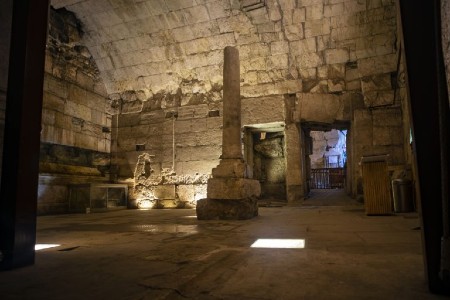Lavish Second Temple ‘City Hall’ Unveiled in Jerusalem
New route on the western wall tunnels walk set to open soon
By Nathan Steinmeyer
July 23, 2021
 Remains of the magnificent 2,000-year-old building recently excavated and soon to be opened to the public. Credit: Yaniv Berman, Israel Antiquities Authority
Remains of the magnificent 2,000-year-old building recently excavated and soon to be opened to the public. Credit: Yaniv Berman, Israel Antiquities AuthorityEarlier this month, the Israel Antiquities Authority (IAA) revealed the excavations of a lavish first-century C.E. public building in Jerusalem. The building, located near the Western Wall, may have served as a reception hall for important officials and dignitaries on their way to worship in the Temple. Although the hall was first discovered at the end of the 19th century, the IAA’s recent work aimed to completely reveal what remains of the building. With the completion of excavations, the building is set to be incorporated into the the Western Wall Tunnel tour in the next few months. The Western Wall Tunnel is an underground exhibition stretching half a kilometer along the famous Western Wall, allowing visitors to get up close to the ancient history of Jerusalem.
According to Shachar Puni, architect for the IAA’s Conservation Department, “The new route provides a better understanding of the complex and important site known as the Western Wall Tunnels, while emphasizing the extent of this magnificent building. It creates a new visitors’ route that passes through the building and leads to the spacious compound at the foot of Wilson’s Arch.”
The building was first uncovered by explorer and surveyor Charles Warren in the 19th century, but it was only during the most recent excavations that its full extent became known. The building, which is suggested to have been a type of city hall, consists of the main hall, lined with heavy columns topped by Corinthian capitals, creating two side chambers. Insider the main hall was an ornate fountain, fed through lead pipes. The side rooms would have served as feasting halls, with reclining wooden sofas built into the walls, as was common in the Hellenistic and Roman worlds. A later phase of the building saw extensive changes to the building, with a ritual bath (mikveh) added to the main hall so that visitors could purify themselves before making their way to the Temple.
Constructed between 20 and 30 C.E., the building stood as an example of the opulence and wealth of the city of Jerusalem during the time of the Herods. Little did the builders know that it would only be a few decades later, in 70 C.E., that the Roman general Titus would conquer Judah, following a failed Jewish rebellion, and destroy much of the city of Jerusalem.
This article originally appeared here.